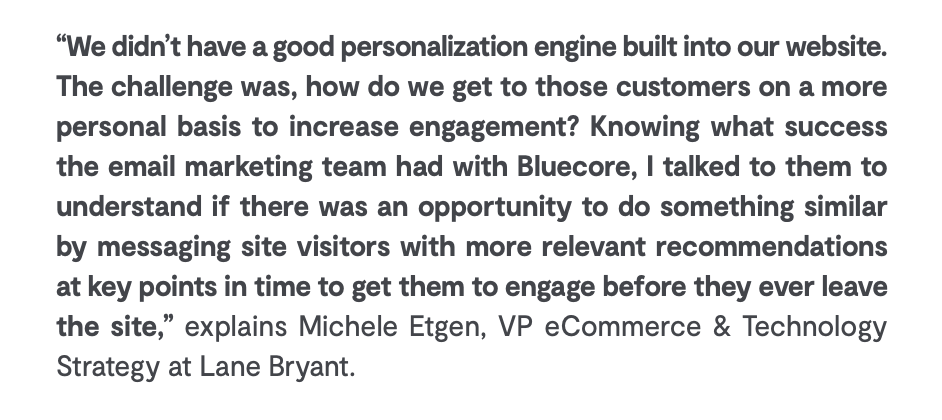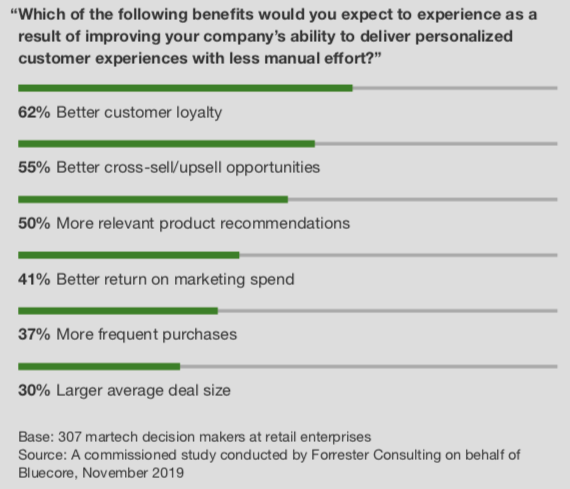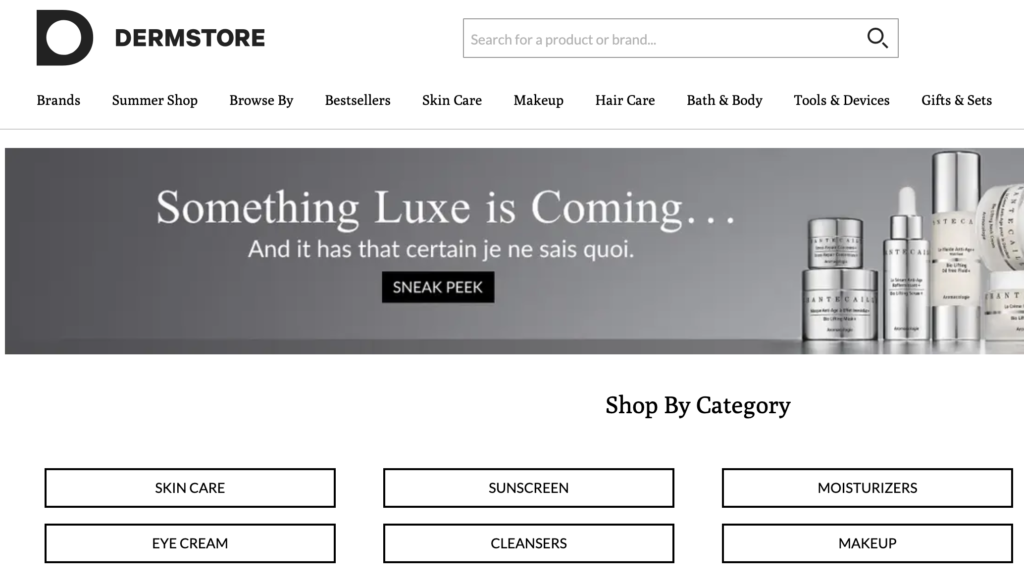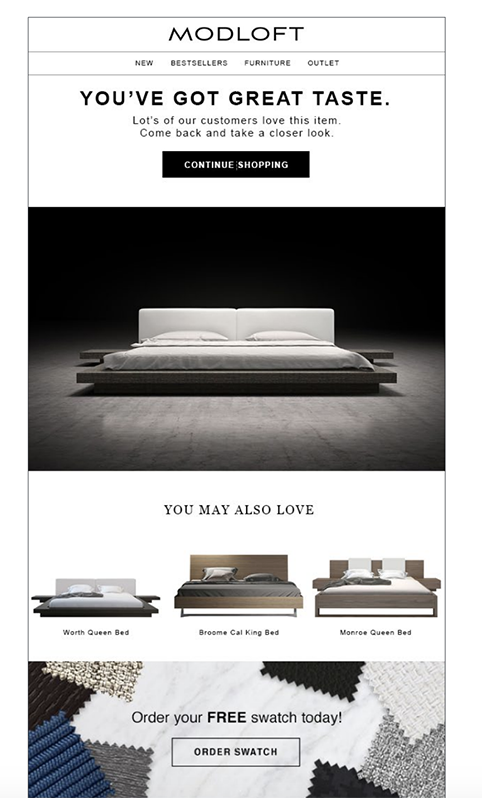Ecommerce Personalization: A Complete Guide for Retailers
By now you’ve probably heard of personalization. These days, it’s the buzzword on every ecommerce business owner’s mind.
But don’t let the possible overuse (or occasional misuse) of the word turn you off. There’s a good reason why personalization still occupies the x of good.
Personalization is a proven way to boost sales, improve loyalty, and grow your ecommerce business. Why? Because satisfied customers who have a great experience with your ecommerce brand not only come back again and again, they also tell their friends.
So here’s everything you need to know about ecommerce personalization: what it is, why it works, and strategies you can use to deliver a solid personalized experience for your customers.
[Download our 2022 Retail Ecommerce Benchmark Report]
What Is Ecommerce Personalization?
Ecommerce personalization is the process of creating targeted online shopping experiences that deliver personalized user journeys for shoppers based on relevant data points.
Personalizing your customers’ ecommerce journeys involves taking what you’ve learned about them and using that knowledge to improve their experience of your business — and then tailoring those journeys to their needs, wants, and interests. This is a strategic, analytic, and creative process — one that takes into account everything from content and graphics to browsing history, the tech a customer is using (like a PC or on their phone) and everything in between.
Why Ecommerce Personalization Matters
Covid has had a huge impact on the ecommerce industry, creating a massive digital shift in shopping habits. Many people spent — and continue to spend — increasing amounts of time online, with 75% of consumers having tried at least one new shopping behavior during the pandemic.
And the brands that capitalized on this shift are the ones now leading the way in ecommerce personalization. Not only does personalization improve customer experience, but it also increases revenue and conversions. For example, during the digital shopping shift, Lane Bryant focused on building its ecommerce presence (and improving customer experience) to offset decreasing in-store revenue. As a result, they saw a 5x increase in revenue, leading to a 63% lift in conversions.

The point is that ecommerce personalization works. A focus on creating increased engagement with your website visitors will give you a competitive edge. Personalization that makes customers feel that the brand they’re engaging with cares about them and their preferences increases trust, loyalty, and overall satisfaction.
Ecommerce personalization enables you to capitalize on the major digital shift still happening today by strengthening the way your brand interacts with customers before, during, and after a conversion.
The Benefits of Retail Ecommerce Personalization
Personalization isn’t just about creating happy customers. There are quantitative results that come from having customers that feel satisfied, seen, and valued. These include:
- Higher conversion rates. Personalized shopping experiences encourage conversion through ease of use, a tailored and guided journey, and informed customer service that provides solutions specifically designed for your customers.
- Increased customer loyalty. No one likes to buy from a brand they dislike or one that makes them feel less like a person than a number. Customers value the sense of security that comes with a personalized experience that meets them where they are — and guides them from there.
- Increased retention. While 74% of any retailer’s customers are of the one-and-done variety, about 70% of revenue sits with already active customers. Retention is the name of the game, and personalized experiences are exactly what keep customers coming back and back again.
8 Best Practices and Strategies for Ecommerce Retailers
Done right, ecommerce personalization yields a bonanza in profits, retention, and more. Done poorly, you’ll get the exact opposite. Find the right technology and strategies that work for you, your brand and — most importantly — your customers.

Below are some of the most common strategies and best practices used by ecommerce retailers to capitalize on the power of customer personalization.
1. Personalized Product Recommendations
The first rule of personalization is to provide useful content, suggestions, and recommendations. If you’re not providing information that your customers find useful, you haven’t really hit the personalization nail on the head. Product recommendations keep customers in the know, and informed customers feel more secure in their purchases.
The ability to provide personalized product recommendations based on purchasing or browsing behaviors is a powerful strategy, one you need to adapt to your particular brand, products and – again, most importantly – your customers. The right personalization software will make implementing this particular strategy as easy and effective as possible.
2. Leverage Data Effectively
By leveraging data like browsing history and purchase history, you can provide relevant content and recommendations across all channels. But first, you need to figure out how to manage the glut of information all those channels and sources will yield.
Making sense of who is doing what, when, where, and why is a challenge for every marketer and brand trying to stay on top in a world where personalization isn’t just a buzzword, but the norm
So, how can you collect, analyze, and make sense of your data?
Simply, by using the right data model built specifically for the ecommerce retail space. Retail-specific data modeling lets you incorporate data that is related not only to behaviors but also to your products, yielding a predictive system that helps you put the right products in front of the right customers at the right time, with less effort. Higher yields from less work? That’s a big win.
3. Grow with Email Capture
We all know that to grow, a brand needs to first grow its email list. From coaches and consultants hawking webinars to your friendly neighborhood hardware store running a special on rain spout screens, email is the best way to put your products, services, and brand in front of people who are already interested in what you have to offer.
Personalized emails increase click rate by 139% in comparison to static one-time emails that just feel standard and bland. There’s an 8.8% click rate for price-decrease-triggered emails alone. The trick is creating value so your customers actually want to read your emails when they pop up in their inbox.
4. Work Smarter with Targeted Emails
Emails fold in neatly with overall personalization strategies. Why? Because it’s the Swiss army knife of marketing. You can create an email for just about anything: onboarding, product recommendations, refill reminders or automatic refill notifications, cart abandonment reminders, purchase and shipping information, and so on.
Cart abandonment issues can be highly personalized and tailored to the customer and the product or products they’ve yet to purchase. Build email campaigns around the information and incentive you can provide when a customer abandons their cart. Targeted, automated, behavior-triggered emails are a proven personalization strategy.
5. SMS Campaigns
There’s a reason so many brands offer a text message option to their customers. SMS campaigns are extremely direct, easy to personalize, and versatile — and they carry an open rate approaching 100%.
You can send messages for everything from purchase and delivery information to special offers and new product launches.
A best practice when it comes to texting customers is to make sure you’re not coming on too strong. Texting too often leads to a quick swipe of dismissal, and defeats the purpose of using SMS in the first place. Think in terms of what value and convenience you’re providing when you’re creating an SMS campaign and schedule.
6. Improve UX While Shopping
Browsing and purchasing through your ecommerce retail brand should be as seamless as possible. No one is going to stick around for very long if your website is outdated, unclear, or difficult to navigate. But beyond simple usability, you can incorporate personalization strategies into the browsing process.
Offering lists of “similar products,” “customers also viewed,” and “recently viewed items” all add layers of personalized ease for customers while they compare prices and read product reviews. We all know how easy it is to go down the rabbit hole of online shopping. Help your customers find their way back with personalized, useful features.
7. Promote, Interact, Recommend, and Reward
There is an almost endless variety of ways to effectively and creatively personalize your customers’ experience of your ecommerce brand. These include:
- Widgets: Widgets add a further layer of both personalization and interaction with your brand.
- Unique coupons: Coupons can include special anniversary coupons, discounts, and offers for things like birthdays and holidays.
- Chatbots: Automated chatbots can guide your customers through commonly asked questions and easy-to-resolve issues, as well as log the data from those interactions for your behavior analytics.
- Loyalty programs: Reward your customers for coming back … by encouraging them to come back.
- Daily, weekly, or monthly new product promotions: Keep customers in the know about new products they might be interested in based on previous browsing and purchasing history.
- “Top picks for you” messages: Similar to new product promotions, top picks messages are curated from your existing catalog and targeted to keep customers informed about new products in stock.
8. Segment Successfully
It goes without saying that you need to know your audience in order to create fully realized customer profiles. It’s so important we’re going to say it anyway: You need to know your audience. Targeted online shopping experiences deliver 40% growth in identification and a 73% lift in conversion.
Segmentation is key to implementing personalization strategies for your brand because you need a clear picture of your customers — their needs, wants, and behaviors — before you can successfully tailor those strategies to them.
Segmentation on its own, however, can yield irrelevant personalization — messages and offers that don’t really apply to a customer’s situation. To successfully implement segmentation into your personalization strategy, you need the right technology to evaluate and prioritize the vast amount of data available to you.
Retail Ecommerce Personalization in Action
While there are almost endless opportunities to enact strategies for personalization, knowing where to start can feel overwhelming. It’s important to remember that you don’t need to have strategies in place everywhere all at once. You can start at a place and a speed that makes sense for your brand and customers.
Check out these examples of personalization in action to inspire your own strategies as you move forward.
Restock and Replenish: Dermstore
As a beauty brand, ecommerce retailer Dermstore specializes in products that are made to be used — not kept around up on a shelf. They’ve created a personalization strategy around “restock and replenish” reminders about previous purchases.

These reminders — which are sent at automated intervals based on individual consumers’ purchase history and patterns — come at times when customers have already made a mental note to stock back up on favorite products that are getting low. When this email comes in, it sparks an “Oh yeah, that’s right!” moment, which is the exact kind of connection brands want to inspire.
Next Best Purchase: Sephora
Sephora, another beauty brand, uses its personalization strategy in part to convert single-category shoppers into multi-category shoppers. In other words, they actively encourage customers who to date have only purchased one, or one kind of product, to explore other products as well.
To do this, Sephora created “next best purchase” recommendations aimed at introducing customers to personally curated selections of products they’re most likely to be interested in. Akin to “similar product” recommendations, “next best purchase” has a more personal feeling to it, telling customers these are the next best purchase ideas specifically for them.
Search Abandonment: Modloft
As broad as search abandonment can seem, with the right technology in place, creating targeted and triggered search abandonment notifications is possible. Many people, when in the initial research stages before purchasing, will visit more than one site to check out different brands’ products. And as always on the internet, it’s all too easy for those shoppers to get caught up in the hunt and not remember exactly where they saw which product.

With furniture retailer Modloft’s auto-populated search abandonment messages, customers get that “Oh yeah, that’s right!” moment, leading them back to Modloft’s website and its products.
Personalize the Way You Connect
Intelligent ecommerce personalization gets the right messages in front of the right customers at the right time, every time. Connecting with your customers in a way that provides value to them is what personalization is all about. Without that value, every single one of your personalization strategies and efforts will fail.
It’s up to you to take the time and make the effort to learn your customers, collecting data and putting it to work in a way that works not only for you but for them.



